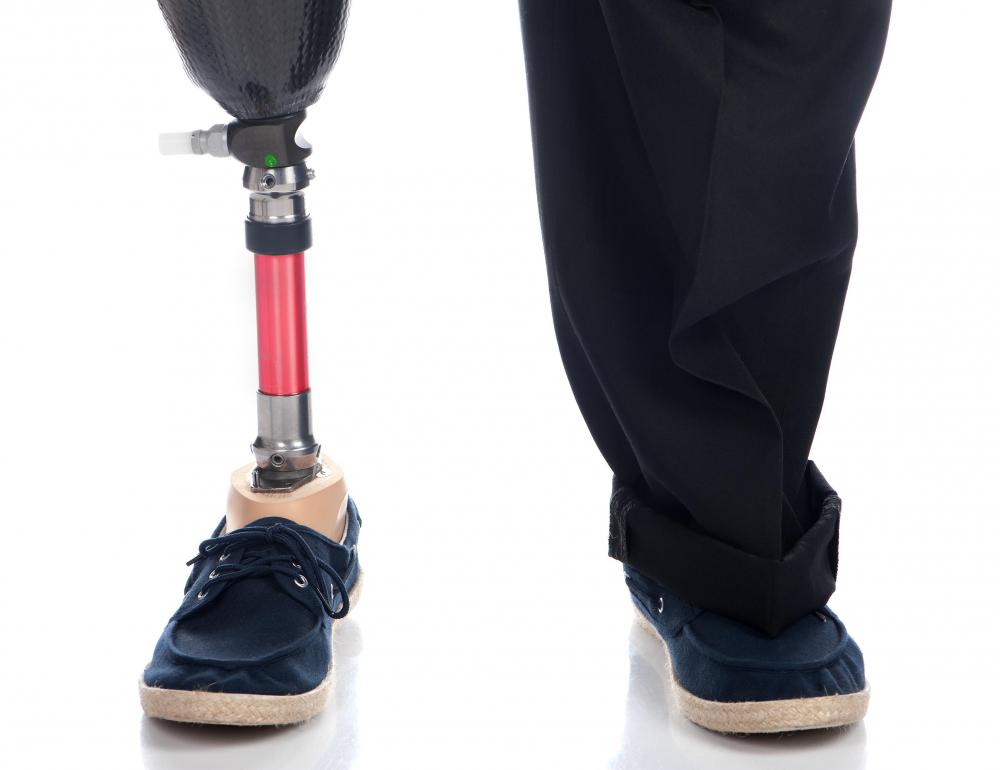At TheHealthBoard, we're committed to delivering accurate, trustworthy information. Our expert-authored content is rigorously fact-checked and sourced from credible authorities. Discover how we uphold the highest standards in providing you with reliable knowledge.
What is a Prosthetic Foot?
A prosthetic foot is a foot made of plastic, metal, or a combination of the two, that is worn by a person who has either lost their foot or is born without one. Various birth defects can lead to the loss of a foot or the birth of an infant without a foot. Also, there are numerous kinds of diseases and injuries that can leave a person without a foot. Unfortunately, there are numerous soldiers who return from duty missing a body part.
Because there are so many different circumstances that can lead to a missing foot, there are also numerous kinds of prosthetic feet. A prosthetic foot may attach to a person's ankle or calf and, therefore, compensate for a completely missing foot. Sometimes, instead of being attached to a leg, the foot is attached to another prosthesis that is replacing a leg. A prosthetic foot may also attach to a remaining part of a person's foot and simply compensate for the missing parts.

It is possible to thoroughly disguise a prosthetic foot. Because prosthesis are intended to model and serve in the place of missing body parts, they are generally shaped like the missing parts. Therefore, prosthetic feet almost always fit into standard shoes. While they might function well inside fashionable footwear like high heels or open-toed shoes like sandals and flip flops, they will fit into most flat shoes. Therefore, it is possible to have a prosthesis while still functioning and appearing like every other able-bodied people.

Just as the medical field gets more advanced every year, so does the field of prosthetics. Long gone are they days when people missing a leg had to hobble about on a wooden peg. While prosthetics do not perfectly compensate for missing body parts, they can help people to function nearly normally. With prosthetic feet, for example, it is possible to walk on a prosthetic foot with little or no limping.

It is important to understand the difference between the terms prosthetic and bionic. A prosthesis may have moving parts that allow a person to move in a manner similar to someone with all of their body parts. However, a prosthesis like a prosthetic foot cannot move on its own. A bionic prosthesis, however, can move on its own. For example, a prosthetic foot would not have toes that could move and grip the ground. A bionic foot could.
AS FEATURED ON:
AS FEATURED ON:













Discussion Comments
I am an AK amputee and having a problem that just started. when I walk and come over it feels like the ball of the foot is gong over a lump. It is not as smooth as it was. I'm from Michigan but in Texas and can do this myself. Want to know if I need to adjust the Dorsi or Plantar to get relief.
One of the most difficult aspects of fitting a prosthetic limb of any kind is comfort.
I know some people who are always in pain, simply because they can't use their prosthetic sockets without irritating the end of the original limb.
They are getting more and more advanced in dealing with this kind of thing, but it is still very difficult.
My heart goes out to everyone who has to deal with this.
The prosthetic feet used in the Paralympics games are usually of the highest quality materials and have had a lot of technology go into them.
They often don't even bother to make it look like a foot, or to wear a shoe. They just try to make it work as well as it can so they can try and come first in the race.
It's made out of a material they use in airplanes, so it is super strong and flexible.
It's expensive though, so it's a shame they don't often get as much funding and sponsorship as Olympian athletes.
Post your comments